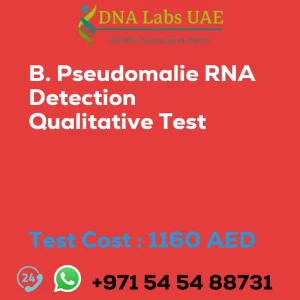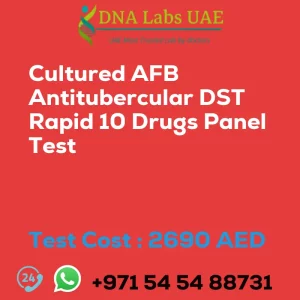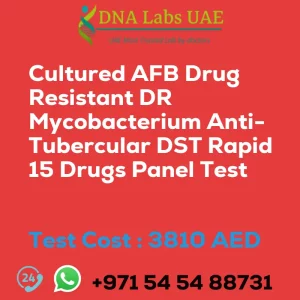Cryptococcus RNA Detection Qualitative Test
Test Name: Cryptococcus RNA Detection Qualitative Test
Components: Price: 1160.0 AED
Sample Condition: Fresh tissue biopsy specimens, skin biopsy specimen from a patient with disseminated nodular skin lesions, tissue specimens from a variety of body sites (brain, skin and soft tissue, eye, bone, lung, cardiac valve, and bone marrow), peripheral blood specimens, respiratory secretions.
Report Delivery: 4th Working Day Email: 48 hours. On phone: 36 hours
Method: Real Time PCR
Test Type: Viral
Doctor: Physician
Test Department: Genetics
Pre Test Information: Need to sign Consent document and bring any clinical history of patient for Cryptococcus (RNA Detection) Qualitative Test
Test Details:
The Cryptococcus RNA Detection Qualitative Test is a diagnostic test used to detect the presence of Cryptococcus neoformans or Cryptococcus gattii in patient samples. Cryptococcus is a type of fungus that can cause severe infections, particularly in individuals with weakened immune systems.
The test utilizes a technique called reverse transcription polymerase chain reaction (RT-PCR) to detect the RNA (genetic material) of Cryptococcus in the patient sample. This test is highly sensitive and specific, meaning it can accurately identify the presence of the fungus.
To perform the test, a sample is collected from the patient, usually from the cerebrospinal fluid (CSF) in cases of suspected meningitis or from other bodily fluids or tissues. The sample is then processed in the laboratory to extract the RNA.
The extracted RNA is then converted into complementary DNA (cDNA) using an enzyme called reverse transcriptase. This cDNA is then amplified using PCR, which creates millions of copies of the specific RNA sequence if present in the sample.
The amplified cDNA is then analyzed using various techniques, such as gel electrophoresis or fluorescent probes, to determine the presence or absence of the target RNA sequence from Cryptococcus.
A positive result indicates the presence of Cryptococcus RNA in the sample, suggesting an active infection. A negative result suggests the absence of the fungus or a very low level of RNA that is below the detection limit of the test.
The Cryptococcus RNA Detection Qualitative Test is a valuable tool for diagnosing cryptococcal infections, particularly in cases where traditional culture methods may be time-consuming or have low sensitivity. Early detection and treatment of Cryptococcus infections are crucial for improving patient outcomes.
| Test Name | Cryptococcus RNA Detection Qualitative Test |
|---|---|
| Components | |
| Price | 1160.0 AED |
| Sample Condition | fresh tissue biopsy specimens, skin biopsy specimen from a patient with disseminated nodular skin lesions, tissue specimens from a variety of body sites (brain, skin and soft tissue, eye, bone, lung, cardiac valve, and bone marrow), peripheral blood specimens, respiratory secretions. |
| Report Delivery | 4th Working Day Email : 48 hours.On phone : 36 hours |
| Method | Real Time PCR |
| Test type | Viral |
| Doctor | Physician |
| Test Department: | Genetics |
| Pre Test Information | Need to sign Consent document and bring any clinical history of patient forCryptococcus (RNA Detection) QualitativeTest |
| Test Details |
The Cryptococcus RNA Detection Qualitative Test is a diagnostic test used to detect the presence of Cryptococcus neoformans or Cryptococcus gattii in patient samples. Cryptococcus is a type of fungus that can cause severe infections, particularly in individuals with weakened immune systems. The test utilizes a technique called reverse transcription polymerase chain reaction (RT-PCR) to detect the RNA (genetic material) of Cryptococcus in the patient sample. This test is highly sensitive and specific, meaning it can accurately identify the presence of the fungus. To perform the test, a sample is collected from the patient, usually from the cerebrospinal fluid (CSF) in cases of suspected meningitis or from other bodily fluids or tissues. The sample is then processed in the laboratory to extract the RNA. The extracted RNA is then converted into complementary DNA (cDNA) using an enzyme called reverse transcriptase. This cDNA is then amplified using PCR, which creates millions of copies of the specific RNA sequence if present in the sample. The amplified cDNA is then analyzed using various techniques, such as gel electrophoresis or fluorescent probes, to determine the presence or absence of the target RNA sequence from Cryptococcus. A positive result indicates the presence of Cryptococcus RNA in the sample, suggesting an active infection. A negative result suggests the absence of the fungus or a very low level of RNA that is below the detection limit of the test. The Cryptococcus RNA Detection Qualitative Test is a valuable tool for diagnosing cryptococcal infections, particularly in cases where traditional culture methods may be time-consuming or have low sensitivity. Early detection and treatment of Cryptococcus infections are crucial for improving patient outcomes. |








